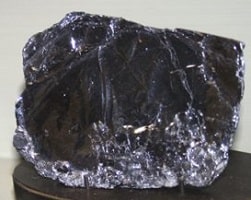The Difference Between Polar and Nonpolar in tabular form
The polarity and Non-polarity of a molecule depend upon the electronegativity of chemical compounds. The atom which has more electronegativity forms the ionic bond or a polar covalent bond. The ionic bond is formed when the electronegativity atom takes an electron completely from another molecule. When an electron pulls the electron towards itself, it forms a polar covalent bond. Although the disparate sharing of electrons of atoms results in the bond possessing a partial positive and negative end.
Difference Between Polar and Nonpolar in Tabular form
|
Polar |
Nonpolar |
| The compounds are polar that contain strong forces and form dipole-dipole bonds. They also form Hydrogen-bonds. | The compounds that contain weak forces and form London dispersion forces are called nonpolar. They also contain Van der Waal interactions between nonpolar bonds |
| The polar compound is extremely asymmetrically arrayed. | Nonpolar compounds contain symmetrical polar bonds. |
| The polar molecule can be indicated when a molecule possessed zero dipole moment. E.g. H2O | The nonpolar molecule has a significant dipole moment value. Example: CCl4, pentane, hexane, and Oil |
| A polar molecule contains an equal distribution of electron density. | A nonpolar molecule contains Unequal distribution of electron density. |
| It possesses an electronegativity difference between atoms is ˂o.4. | It possesses an electronegativity difference between atoms is ˃0.4. |
| Dipole moment | No dipole moment |
| Charge separation | No charge separation |
Polar Vs Nonpolar
The bond that possesses the polar covalent bonds, but may not be a polar compound. The main reason behind it is that while the presence of net dipole in a polar compound. Polar is asymmetrically arrayed.
For example, water possesses both partial positive charges and cannot cancel out. While Nonpolar compounds can share entire electrons and contain symmetrical polar bonds, that cancel out some sort of net dipole. E.g. Boron Trifluoride (BF3), the polar bonds are arrayed in a single plane and cancel out each other.
Polar Molecules
Polar molecules form when two atoms do not share electrons equally in a covalent bond. A dipole forms, with part of the molecule carrying a slight positive charge and the other part carrying a slight negative charge. A molecule becomes polar if there is a difference between the electronegativity values of each atom.
An extreme difference forms an ionic bond, while a lesser difference forms a polar covalent bond. If the electronegativity difference between the two atoms is between 0.5 and 2.0, the atoms form a polar covalent bond. If the electronegativity difference between the atoms is greater than 2.0, the bond is ionic. Ionic compounds are extremely polar molecules.
Example: HCl, H2O, N2O, etc. Polar substances behave like tiny electric dipoles because polar molecules have a permanent electric dipole moment.
Examples of polar molecules
- Water – H2O
- Ammonia – NH3
- Sulfur dioxide – SO2
- Hydrogen sulfide – H2S
- Ethanol – C2H6O
Non-Polar Molecules
Examples of homonuclear nonpolar molecules are oxygen (O2), nitrogen (N2), and ozone (O3). Other nonpolar molecules include carbon dioxide (CO2) and the organic molecules methane (CH4), toluene, and gasoline.
Example:
Any molecule with lone pairs of electrons around the central atom is polar. Methanol is polar. The two oxygen atoms pull on the electrons by exactly the same amount. Propane is nonpolar,
In chemistry, covalent bonds between atoms can be classified into polar or non-polar depending on how their shared electrons are distributed between the two elements they are holding together.
Examples of nonpolar molecules include:
- Any of the noble gasses: He, Ne, Ar, Kr, Xe (These are atoms, not technically molecules.)
- Any of the homonuclear diatomic elements: H2, N2, O2, Cl2 (These are truly nonpolar molecules.)
- Carbon dioxide – CO2
- Benzene – C6H6
- Carbon tetrachloride – CCl4
- Methane – CH4
- Ethylene – C2H4
- Hydrocarbon liquids, such as gasoline and toluene
- Most organic molecules
Related : What are macromolecules?
Why Does Polarity Matter?
Chemical polarity plays a huge role in how different molecules interact. For example, why does sugar dissolve in water while oil does not?
Water is a polar solvent. The oxygen atom contains two lone pairs and is more electronegative than hydrogen, thus pulling the electrons towards themselves. As a result, the oxygen atom has a partial negative charge associated with it. The hydrogens on the other hand are essentially protons and have a partial positive charge associated with them.
Sugar is also polar! It has many hydroxyl (OH) groups that readily make hydrogen bonds. Sugar thus has both partial positive and negative charges associated with it. As a result, there are hydrogen bond donors and acceptors in both water and in sugar. For this reason, sugar will dissolve in water.
What is Polar Bond?
A polar bond is a chemical joining together of two elements with a difference in electronegativity of greater than 0.4 and less than 1.8.
Negatively charged electrons are shared between the two connected atoms (known as a molecule), however, the difference in electronegativity causes the electrons circulating around the nuclei of each atom to be unevenly distributed between the two.
What is NonPolar Bond?
If a polar bond is one where shared electrons are unevenly distributed between two atoms, then it stands to reason that when electrons are shared evenly across the two atoms, the resulting bond is known as non-polar.
The difference in electronegativity in non-polar covalent bonds must be between 0-0.4 so that the negatively charged electrons are shared evenly (or very close to evenly) between the two atoms due to a lack of electromagnetic “pull” from either atom.
Related Topics :




